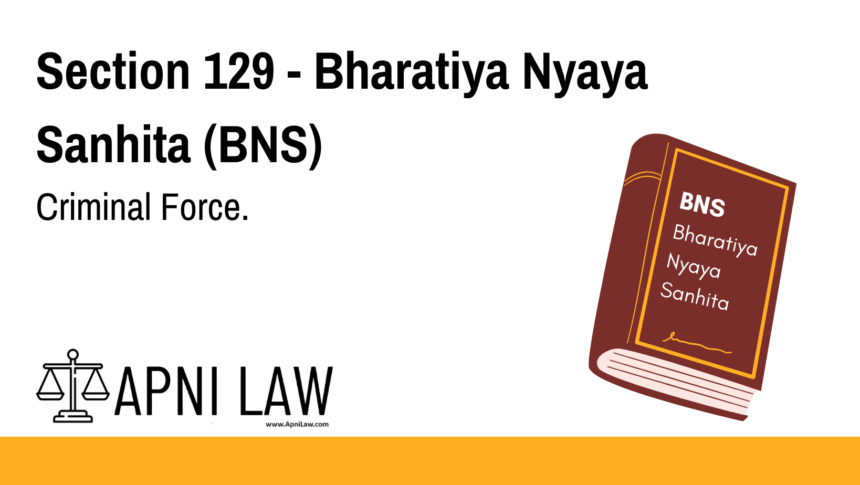Code: Section 129 BNS
Whoever intentionally uses force to any person, without that person’s consent,
in order to the committing of any offence, or intending by the use of such force to cause, or
knowing it to be likely that by the use of such force he will cause injury, fear or annoyance to
the person to whom the force is used, is said to use criminal force to that other.
Illustrations.
(a) Z is sitting in a moored boat on a river. A unfastens the moorings, and thus
intentionally causes the boat to drift down the stream. Here A intentionally causes motion to
Z, and he does this by disposing substances in such a manner that the motion is produced
without any other action on any person’s part. A has therefore intentionally used force to Z;
and if he has done so without Z’s consent, in order to the committing of any offence, or
intending or knowing it to be likely that this use of force will cause injury, fear or annoyance
to Z, A has used criminal force to Z.
(b) Z is riding in a chariot. A lashes Z’s horses, and thereby causes them to quicken
their pace. Here A has caused change of motion to Z by inducing the animals to change their
motion. A has therefore used force to Z; and if A has done this without Z’s consent, intending
or knowing it to be likely that he may thereby injure, frighten or annoy Z, A has used criminal
force to Z.
(c) Z is riding in a palanquin. A, intending to rob Z, seizes the pole and stops the
palanquin. Here A has caused cessation of motion to Z, and he has done this by his own
bodily power. A has therefore used force to Z; and as A has acted thus intentionally, without
Z’s consent, in order to the commission of an offence. A has used criminal force to Z.
(d) A intentionally pushes against Z in the street. Here A has by his own bodily power
moved his own person so as to bring it into contact with Z. He has therefore intentionally
used force to Z; and if he has done so without Z’s consent, intending or knowing it to be
likely that he may thereby injure, frighten or annoy Z, he has used criminal force to Z.
(e) A throws a stone, intending or knowing it to be likely that the stone will be thus
brought into contact with Z, or with Z’s clothes, or with something carried by Z, or that it will
strike water and dash up the water against Z’s clothes or something carried by Z. Here, if the
throwing of the stone produce the effect of causing any substance to come into contact with
Z, or Z’s clothes, A has used force to Z, and if he did so without Z’s consent, intending
thereby to injure, frighten or annoy Z, he has used criminal force to Z.
(f) A intentionally pulls up a woman’s veil. Here A intentionally uses force to her, and if
he does so without her consent intending or knowing it to be likely that he may thereby
injure, frighten or annoy her, he has used criminal force to her.
(g) Z is bathing. A pours into the bath water which he knows to be boiling. Here A
intentionally by his own bodily power causes such motion in the boiling water as brings that
water into contact with Z, or with other water so situated that such contact must affect Z’s
sense of feeling; A has therefore intentionally used force to Z; and if he has done this
without Z’s consent intending or knowing it to be likely that he may thereby cause injury,
fear or annoyance to Z, A has used criminal force.
(h) A incites a dog to spring upon Z, without Z’s consent. Here, if A intends to cause
injury, fear or annoyance to Z, he uses criminal force to Z.
Explanation of Section 129 BNS
What is Criminal Force?
Criminal force is an aggravated form of force as defined in Section 128 BNS. It involves intentional use of force on another person without consent, with the aim to:
- Commit an offense.
- Cause injury, fear, or annoyance.
Key Elements of Criminal Force
- Intentional Use of Force: The force must be deliberate, not accidental.
- Without Consent: The victim must not have agreed to the act.
- With a Criminal Intent:
- To commit an offense.
- To cause injury, fear, or annoyance.
Illustrations of Criminal Force
The following examples illustrate how criminal force is applied under different circumstances:
Example 1: Moving a Boat Without Consent
Z is sitting in a moored boat. A unfastens the boat, causing it to drift.
✅ A has used force because he caused motion to Z.
✅ Since it was done without Z’s consent, intending to cause fear or annoyance, A has used criminal force.
Example 2: Inciting a Horse to Speed Up
Z is riding in a chariot. A lashes the horses, making them move faster.
✅ A has caused motion to Z through the horses.
✅ If done without Z’s consent, with the intent to scare or annoy, A has used criminal force.
Example 3: Stopping a Moving Palanquin
A stops Z’s palanquin by seizing its pole, intending to rob Z.
✅ A has used force by causing the cessation of motion.
✅ Since it was done with criminal intent, it is criminal force.
Example 4: Pushing Someone in Public
A deliberately pushes against Z in the street.
✅ A has used force by moving his own body into contact with Z.
✅ If done without Z’s consent, intending to cause fear or annoyance, it becomes criminal force.
Example 5: Throwing a Stone
A throws a stone at Z, knowing it may hit him or his belongings.
✅ If the stone comes into contact with Z, it constitutes force.
✅ If thrown with intent to injure, frighten, or annoy, it is criminal force.
Example 6: Pulling a Woman’s Veil
A intentionally pulls up a woman’s veil.
✅ A has used force by moving the veil without consent.
✅ If done with intent to annoy or intimidate, it is criminal force.
Example 7: Pouring Boiling Water
Z is bathing, and A pours boiling water into the bath.
✅ A has used force by causing the water’s motion to affect Z.
✅ Since it can cause injury, fear, or annoyance, it is criminal force.
Example 8: Inciting a Dog to Attack
A provokes a dog to jump on Z.
✅ A has used force indirectly through an animal.
✅ If done with intent to harm or scare, it becomes criminal force.
Common Questions and Answers on Section 129 BNS
1. How is criminal force different from simple force under Section 128 BNS?
- Simple force involves motion or physical contact without criminal intent.
- Criminal force occurs with intent to commit an offense or cause fear, injury, or annoyance.
2. Is accidental contact considered criminal force?
No. For force to be criminal, it must be intentional and without consent.
3. Does causing fear alone make an act criminal force?
Yes. If an act intentionally causes fear or annoyance, it qualifies as criminal force.
4. Is pulling someone’s clothing considered criminal force?
Yes, if done intentionally and without consent, especially with the intent to harass or annoy.
5. How does Section 129 BNS relate to assault?
- Criminal force often leads to assault under Section 130 BNS.
- Assault involves threats or attempts to use force, while criminal force involves actual physical action.
Conclusion
Section 129 of the Bharatiya Nyaya Sanhita (BNS), 2023, defines criminal force as the intentional use of force without consent to commit an offense or cause injury, fear, or annoyance. The law covers direct actions, indirect actions through objects, and force applied via animals.
For more legal insights, visit ApniLaw today! 🚀











